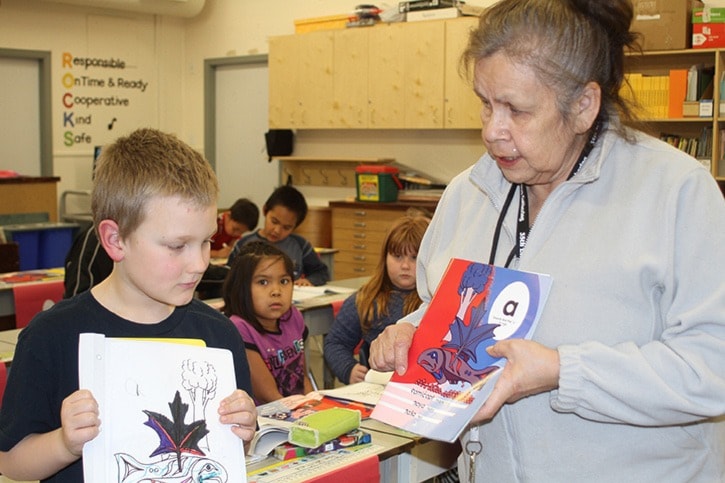For the past six years, Jean Thomas has been going into elementary school classrooms to teach the aboriginal language to young students. This year, Thomas, a Nuu-chah-nulth Education Worker (NEW), is at E.J. Dunn for the first time.
At the age of 66, she is helping to contribute to the preservation and expansion of her heritage.
Thomas goes into the classrooms primarily from Kindergarten to Grade 3, but occasionally up to Grade 6. She started out at Eighth Avenue Elementary, where she returned for the past two years, and prior to that, taught at Gill and Alberni. Her role is to make learning fun and interactive.
“I do activities with the kids,” Thomas said. “We have made button blankets, mini drums and did a series on the Raven Tales movie.”
She also includes activities for the various seasons and holidays. There is also a theory component to her lessons where she has the students write words and letters from the phonetic alphabet.
“I find they pick it up easier in Kindergarten and Grades 1–3,” Thomas said.
The language is evolving, but she can still teach the basics for everyday greetings and conversation.
“(The students) learn numbers, how to say good morning, their names and where they are from.
“Different concepts are trying to change and I wish I could afford to take the courses every time they are offered.”
Learning the language has not always been a priority for Thomas. As a member of the Tseshaht First Nation, she recalls the time when Aboriginal Peoples were banned from speaking their language.
“It is important because for many years we lost the ability to speak or teach,” she said. “When we got that back, I wasn’t interested. I was married to a non-First Nations man and busy raising three kids and working.”
In 2001, she studied in a language learning program and has carried on ever since.
Thomas’ grandfather was instrumental in translating the language into English and travelled all over Canada and the U.S. meeting with archeologists. She inherited the tapes and after listening to them, realized how much she could understand.
“This is a very rewarding job,” she said. “I wish I had gotten to it 20 years ago. I love it and do not miss a single day.”
She said the learning is reciprocal with the French speaking students teaching her words and phrases and has witnessed her teachings become a universal language.
“When we are doing colours and numbers they will teach me the same words in French,” she said. “It is interesting because sometimes I am doing a class and the non-First Nations kids are more interested so then the First Nations kids want to show what they know and not be shy.”
The program promotes the academic success of aboriginal students as recent graduation rates have improved in B.C. The non-completion rate of aboriginal students living on-reserve in B.C. in 2011 was 40.7 per cent, down from 46 per cent in 2006 according to a report by the C.D. Howe Institute. Of those living off-reserve, the non-completion rate in 2006 was 25.4 per cent in B.C. compared to 30.2 per cent nationally.
facebook.com/albernivalleynews
